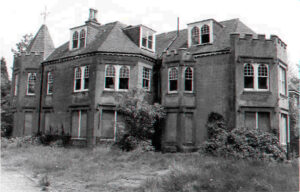West Down Road, Bexhill – (NGR Ref. TQ 7320 0829)
(Previous names: Down Villa, Whindown, Deutsches Paedagogium & Garth Place.)
Details of Property and Buildings:
Land on west side of Bexhill Down. An enclosed piece of former waste of Bexhill Manor. The Duke of Dorset’s estate map c1808, shows the land as open common between the enclosed fields to the west and the unfenced track which later became West Down Road. The fields to the west were at this time part of the Artillery Barracks of the Kings German Legion and covered 5a 3r 12p on this side of the road plus a further 3r 36p on the east side of the road at the junction of roads which later became Broadoak Lane, West Down Road, Gunters Lane and Down Road. From records regarding the Kings German Legion, we know that the horse artillery were stationed here from 1804 to 1814 but it is not certain whether the barracks may pre-date the legions arrival.
In 1840 the land that later became St Francis School is shown as three fields, to the south is an arable field owned and occupied by Samuel Ockenden as part of the former Gun Inn property (see property history no. 10). The main field which was former barrack land is an arable field owned and occupied by Joseph Mitten as part of Beach Farm (buildings in the angle of Broadoak Lane and West Down Road). The third portion was a narrow strip parallel with the road and enclosed after 1808. In 1840 it was a meadow, part of Beach Farm.
It was in a part of this latter field that a large detached building was constructed between 1840 and 1873. The principal elevation was to the south with a small yard and outbuilding to the north. The 1873 Ordnance Survey map shows a garden area to the south of the house and some planting of pine trees. In the 1880s and 1890s it was called Down Villa. In 1894 it was purchased by Dr W F Corfield, and renamed Whindown.
By 1899 the property had been extended to the east and north made possible by the purchase of part of the remaining field to the north which now formed a garden with a detached glass house.
In 1905 to property was sold to Miss W M Campbell who immediately instituted considerable changes. The 1909 O.S. map shows that the field to the west of the house had been purchased by this time and extensive landscaped gardens formed with terraces, additional glass houses and other small buildings. A formal approach drive had also been formed by the purchase of the former Gun Inn to the south, demolishing the cottages that had been formed from the inn and erecting a crenellated lodge house and stables dated 1905(see property history no. 10). The house itself, had been extended to the west with a new wing in a gothic style and it is likely that the older portion of the house underwent cosmetic treatment to conform to the new wing.
From 1910 the property formed school premises and various buildings were added to the north, west and south-west. The first school here was called Deutsches Paedagogium, was an exclusive school for German boys, founded by Dr M F Blassneck. The nephew of the German Kaiser was a pupil here. By 1914 girls were also admitted but in this year Dr Blassneck was arrested at the behest of the military and interned although no formal charges were ever brought against him. During the Great War the buildings were used by the Down School while their building was used as a hospital centre.
The second school to use the property was formed in 1920 by A D B Wauton. It was called Garth Place Preparatory School for boys. Wauton retired in 1938 and the school closed although it continued as a nursery school for one year.
During World War Two the building was used as the temporary headquarters of the wartime administration of the Borough, following the bombing of the town hall in 1940. A special secure underground building was constructed as a local ‘nerve centre’ able to withstand any further attack. The property was also an ARP centre and gas cleansing centre.
In 1946 it was bought by Miss H A Fulford, formerly a teacher at Winceby House School. She founded the St Francis School for Girls. The school and chapel was blessed by Rt Rev C J G Saunders, Assistant Bishop of Chichester. In 1948 the lodge house was converted into a junior school, in 1949 a kindergarten was added and in 1960 a gymnasium constructed.
By the 1970s surplus land had been sold to the north and south and was developed with housing. In the mid 1970s the school closed and the buildings became derelict before redevelopment in the 1980s.
Table of Owners/Use of Buildings
<1888-1889 Eugene Candler Occupier. Known as Down Villa until 1893
1890 Miss Dent Occupier (tenant of Candler?)
1891-1892 Vacant
1893 Eugene Candler Occupier
1894-1903 Dr W F Corfield Owner/occupier. Known as Whindown Villa 1894, Whindown from thereon.
1904 Vacant
1905-1909 Miss W M Campbell Owner/occupier
1910-1914 Dr M F Blassneck Owner/occupier Deutsches Paedagogium school
WW1 Down school
1920-1938 A D B Wauton Owner/occupier Garth School
1939 Nursery school
WW2 Borough of Bexhill/ARP
1946-1974+ Miss Hilda A Fulford B.Sc Lond; FCS; Teachers Dip Lond; AMRST. Head Mistress of St Francis School

SOURCES:
East Sussex Record Office (ESRO)
Duke of Dorest’s estate map and schedule c1808 AMS 5819
ESRO Tithe map and schedule 1840 TDE 141
Ordnance Survey (OS) 25 inch to 1 mile sheet LXX3, 1873, 1899 and 1909
OS 1:1250 sheet TQ 7308SW
Various Local Directories, Bexhill Museum
Bexhill Schools research papers by Norma Day, Bexhill Museum
L J Bartley, local history articles in Bexhill on Sea Observer 1967

